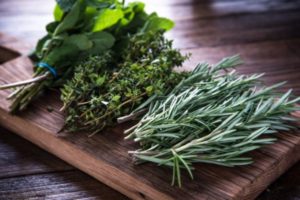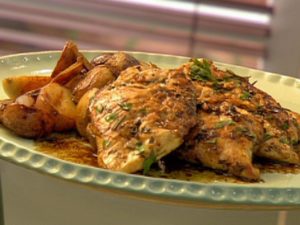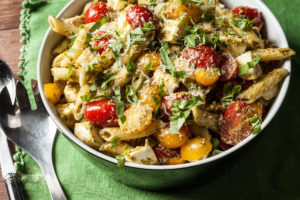
It’s the time of year for testing out your green thumb and for foodies that often means planting an herb garden. For the past few years my husband has thoughtfully planted some of my favorite herbs on Mother’s Day so that I can enjoy them throughout the summer and fall. We generally plant a lot of basil, parsley, chives, thyme and oregano because those are the herbs I use most often. We make sure that they are planted in an area that gets partial sun rather than full sun so that they don’t burn in the heat of the summer. A drip style hose works very well to keep them moist without saturating the roots. If you don’t have a garden area, herbs also make great container plants. Just be sure to use a container that allows ample space for growth and make sure the bottom is lined with a layer of aquarium rocks to allow for proper drainage.
During summer, herbs should be harvested to encourage growth; you do this by pinching them back above leaf buds, where the plant branches out. Once a plant’s energy goes into flower the flavor changes and becomes bitter. Pinch back annuals like basil, dill and cilantro so they will live longer.
Clean herbs in the sink or a large bowl with cool water and dry most in a salad spinner. However, do not dry basil in a salad spinner because it bruises easily. Always dry basil on paper towels.
Storing Fresh Herbs
The best way to store herbs varies from herb to herb. Any herb with stems or roots in tact should be stored stem down in a glass containing 1-2 inches of water. Loosely tent the herbs with a plastic bag to retain the moisture. Herbs such as basil, cilantro, parsley, dill and chervil do very well in this kind of storage. Herbs such as tarragon, sage, thyme, rosemary, oregano, savory and chives, are best lightly wrapped in a damp paper towel and placed in a plastic bag. These herbs will last up to a week (sometimes more) if kept this way.
Drying herbs– Herbs such as oregano, rosemary, mint, thyme, sage and marjoram are the best to dry. Tie them up in bunches by their stems and hang them upside down in a cool dry place for 1 month. After drying, separate leaves and store in glass jars.
Herbs such as oregano, rosemary, mint, thyme, sage and marjoram are the best to dry. Tie them up in bunches by their stems and hang them upside down in a cool dry place for 1 month. After drying, separate leaves and store in glass jars.
Freezing herbs-Thyme, oregano and sage freeze well. Tarragon and parsley will have discoloration. To freeze herbs, clean and dry well. Stack tightly in plastic containers. Herbs can be frozen for 3 months.
Dry vs. Fresh
In most cases a fresh herb is always preferable to its dried counterpart but it’s not always possible to use fresh herbs in every recipe. For this reason most herbs are available in dried form. Dried thyme, oregano, bay leaf, and rosemary are the most commonly used dried herbs. Keep in mind that in order to preserve their color fresh herbs are best used toward the end of cooking while dried herbs are usually added during the cooking process.
It is important to adjust your recipes when using fresh vs. dried because the flavors of fresh herbs are not as concentrated as dried herbs. As a rule you use a 3-1 ratio when substituting fresh for dried. For example: If a recipe calls for 1 tsp. of dried rosemary you would use 3 tsp. of its fresh counterpart. With the milder herbs such as parsley and chives usually a little more of the fresh is necessary. Because parsley is so readily available it is recommended to always use fresh rather than dried.
Because the entire flavor in herbs is in the oils, it is important to keep dried herbs away from any heat source. In fact a cool dark place is the ideal storage spot. When using dried herbs, rub the herbs between your fingers to help bring the oils to the surface, before adding them to a recipe. If you are making a salad dressing or marinade with dried herbs, allow them to steep in the acid (vinegar, lemon juice, wine) several minutes before adding oil to the mix so they have a chance to reconstitute, infuse and develop their flavor. Dried herbs can be added to the recipe closer to the beginning of cooking because it takes 25-30 minutes to fully develop their flavor. Fresh herbs are best added towards the end of the cooking to keep their flavors fresh and at their fullest.
Herbs in Combinations:
Many herbs work well when coupled together, however, some herbs have a very strong and distinct flavor and should be used alone or in combination with milder herbs to avoid a taste competition. Medium herbs can be used in combination with each other or combined with milder ones for full flavor. Seldom is a medium herb combined with a strong herb or are two strong herbs combined with each other. The old song parsley, sage, rosemary and thyme is strictly a lyric not a good culinary decision. The following list of herbs in categories shroud help you when making flavor decisions.
Strong Herbs Medium Herbs Mild Herbs
Tarragon Basil Chives
Sage Oregano Chervil
Rosemary Marjoram Parsley
Cilantro Dill Mint
Winter savory Thyme Scallion
Over The Hill Herbs
If herbs are past their prime don’t throw them out, there are plenty of things to do with them! When grilling throw the dry woody stems into the grill for extra flavor. In the winter throw into you kindling fire for aroma, or set a pot of water with herbs, a clove or two and some orange rind to simmer stovetop and you kitchen will smell delightful.
Here is a list of some common herbs and suggestions for their use:
Basil– Basil compliments tomatoes, used as a flavoring for sauces, pesto, oils and marinades.
Bay leaves-used to flavor stocks, soups, sauces and stews. Leaves dry very well.
Chervil-similar in shape to parsley but more delicate, part of “fine herbes” group, goes with eggs, chicken and shellfish
Cilantro-often called coriander or Chinese parsley, used in Asian, South and Central American dishes. Important ingredient in salsas and uncooked sauces. Flavor is very distinctive.
Dill-Used to flavor stews and braises. Strong flavor used with fish.
Marjoram-Flavor similar to oregano. Use in Mediterranean and Mexican dishes.
Parsley-One of the most common herbs. Used also as garnish and in bouquet garni.
Summer Savory-Flavor similar to thyme. Used in stuffing, salads, hummus and sauces.
Tarragon-Anise flavored. Part of “fines herbes” group, used in salads, omelets and sauces. Once tarragon is picked it has a short life and is too delicate to survive freezing or drying successfully.
Chives-Common perennial part of onion family. Grass like leaves with edible purple flowers used in salads, sauces, compound butters. Part of “fine herbes” group.
Mint-Used in sweet dishes and compliments lamb. Can be invasive if not confined.
Oregano-Used in Mediterranean dishes with beef, veal, lamb, vegetables and sauce. Can be invasive in garden.
Sage-Leaves may be furry or velvety. Strong distinct flavor used in stuffing and sausages. Has an affinity with pork.
Rosemary-Leaves are shaped like pine needles with a strong pine aroma. Used in grilled meat dishes and marinades like lamb, chicken and beef. Dried is almost as good as fresh.
Thyme-Used to flavor stock, soups, stews and braises. Dried is almost as good as fresh. Used in bouquet garni.
Winter Savory-Taste like rosemary. Used in stuffing, stews, sauces and Middle Eastern food.
This article wouldn’t be complete without a few herb friendly recipes. Thanks to Kathleen Sanderson and Diana Albanese for there input and also these great recipes!
Herbed Lemon Chicken Paillard
Serves 8-10
Paillard is simply quick cooking thinly sliced or pounded pieces of meat. Typically this process is associated with veal or chicken, but beef or pork can also be used.
5 whole boneless Chicken breast, split
4 cloves garlic, minced
1 Tbsp. Dijon mustard
¼ cup lemon juice
½ cup Tbsp. fresh chopped herbs (Rosemary, parsley, chives)
1/3 cup olive oil
¼ tsp. red pepper flakes
Salt and cracked pepper to taste
Pre-heat grill.
Prepare chicken: Split and butterfly chicken breast. Place between wax paper and pound to create a thin large piece. (10 in all).
In a large bowl: Combine Dijon, garlic, lemon juice, herbs, olive oil and pepper flakes and mix well. Add to chicken and let stand 25-45 minutes.
Remove chicken from marinade. Set grill on high. Grill chicken –2-3 minutes per-side. Cool and serve warm or room temperature.
Chicken can be served warmed or at room temperature.
© Kathleen Sanderson
Pasta with Summer Tomato Vegetable Sauce and Pesto
Serves 4-6
3 tbsp. extra virgin olive oil
½ cup onions, finely chopped
1 tbsp. garlic, finely chopped
Red pepper flakes to taste
One 28 oz. can Italian tomatoes in juices, broken up with your hands
1 sprig of fresh basil
1 red pepper, cored and finely chopped
½ lb. zucchini, scrubbed, & medium julienned
½ cup pitted calamata olives, split in half lengthwise
1 pound imported penne with ridges
1 tbsp. lemon zest
Pesto Sauce:
2 cloves garlic
2 cups fresh basil leaves
½ cup extra virgin olive oilor more
¼ cup toasted pine nuts
½ cup grated parmesan Cheese
Kosher salt and freshly ground black pepper
Place a large sauté pan over medium heat. Add onion, garlic and red pepper flakes,. When onions are soft (about 5 minutes) add tomatoes and sprig of basil. Cook for 15 minutes.
Add red peppers and zucchini and continue cooking for 10 minutes. Add olives and turn off heat. Season to taste. The sauce can be made a few hours ahead up to this point.
While sauce is cooking make pesto. Place garlic, basil, oil and pine nuts in a blender or food processor and mix until blended. Pour into a bowl and mix in grated cheese by hand. Season to taste.
Bring a large pot of water to boil, add salt and cook pasta until al dente. Drain pasta and add to vegetable sauce. Toss to combine.
Serve pasta with a dollop of pesto. Sprinkle with Parmesan cheese if desired.
© Diana Albanese
Lastly – if you want to learn more about herbs and enjoy more great recipes Chef Kathleen Sanderson is teaching “Herbs Glorious Herbs” on June 27th! Here’s the page on our website with more information:
https://www.tasteandtechnique.com/class/herbs-glorious-herbs/
